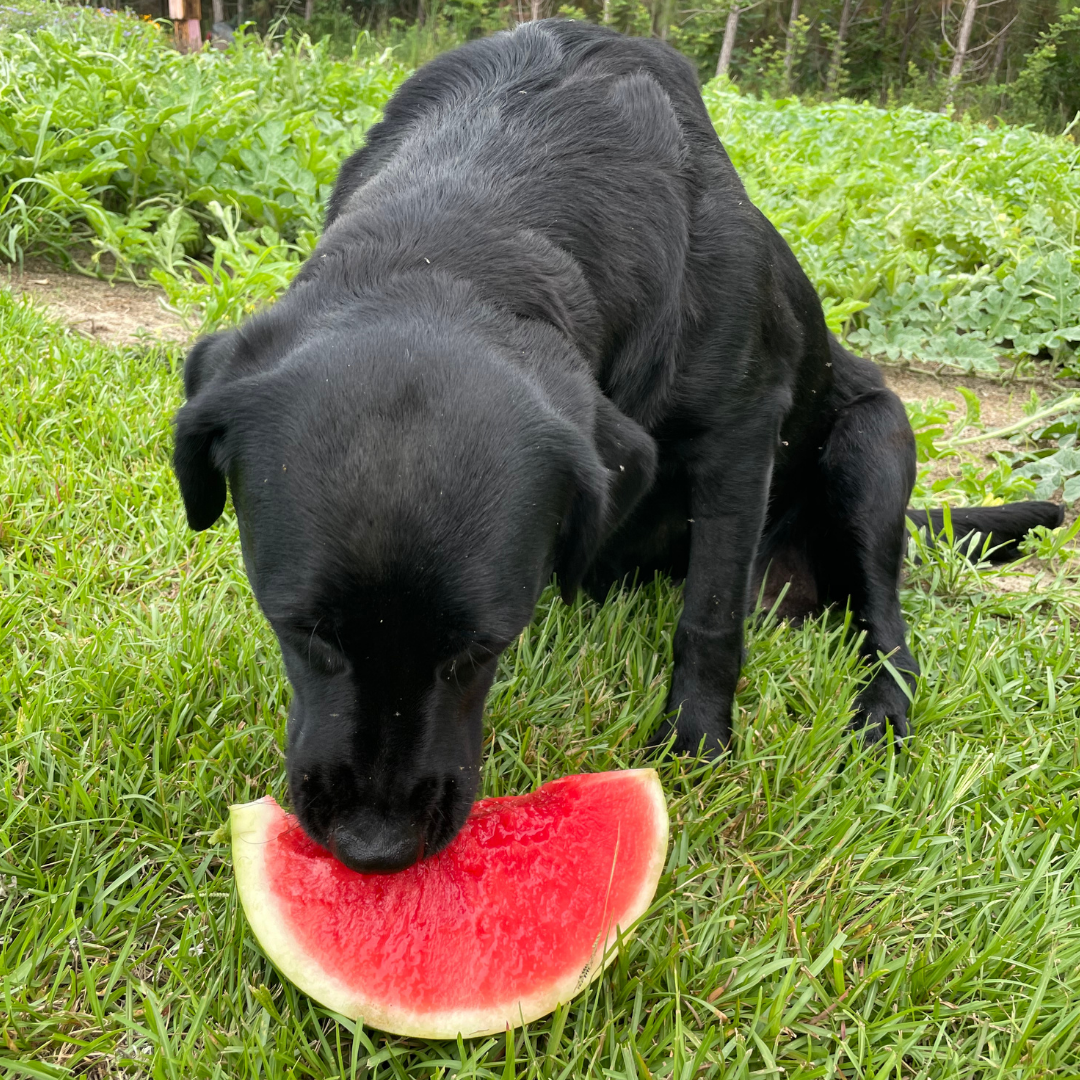Last year we tried growing seedless watermelons for the first time, and we were pleasantly surprised with the results. Our production levels per plant weren't to the standards or the commercial watermelon growers around here, but it wasn't too bad either. We ended up harvesting around 15-20 beautiful seedless watermelons from a short 30' row in our backyard garden.
Why Seedless Watermelon?
There seems to be a stigma amongst some gardeners that seedless watermelons aren't as sweet as some of the older, seeded watermelon varieties. We didn't find this to be true at all. The seedless watermelons we grew were sweet and delicious when harvested using the tell tale signs of watermelon ripeness.
I think some of that stigma comes from the unpredictability of choosing a whole watermelon at the grocery store. When you pick a watermelon from a big bin, you have no idea whether that watermelon is underripe, overripe, or just right. You're at the mercy of the grower who picked it. But when you grow your own, you can pick them when they're perfect!
How Do You Get Seedless Watermelon Seeds?
We get this question quite a bit. How do you plant a seedless watermelon if it has no seeds? This can get complicated and it's part of the reason why seedless watermelon seeds are so expensive. But we'll try to explain it as simply as possible. Let's start with the standard procedure for seeded watermelons.

Seeded Watermelons
A standard watermelon seed has two copies of each chromosome. In biological terms, this is called a "diploid" or 2n individual. When that seed is planted and becomes a watermelon plant, it produces male and female flowers. The male flowers have pollen which contains one copy of each chromosome. This is called "haploid" or 1n. The female flowers contain eggs which are haploid or 1n as well.
When the pollen from the male flower fertilizes the egg on the female flower, the result is a diploid fruit (1n + 1n = 2n). This is standard procedure for most things in nature. Same thing with humans -- haploid (1n) sperm fertilizes haploid (1n) egg to make beautiful diploid (2n) baby.

Seedless Watermelons
Sterility is usually caused by an individual (or fruit) having three sets of each chromosome. This is called "triploid" or 3n. This process starts with the plant breeders who treat standard (seeded) watermelon seeds with colchicine. This is a harmless chemical that is used to treat gout in humans, but coincidentally it also is used to double the chromosome number in watermelons.
After being treated with colchicine, the watermelon plant has twice the chromosomes it once had and now produces watermelons with seeds that are "tetraploid" or 4n. So when you buy seedless watermelon seeds (oxymoron, I know), you're actually buying tetraploid seeds.
But that's not the end of the process. To get the sterile watermelon, you have to grow the tetraploid plants amongst standard diploid plants. The seedless plants don't make many (if any) male flowers, so it's pretty much all female flowers with eggs that are 2n. As mentioned earlier, the standard diploid plants have pollen grains that are haploid or 1n. When a 1n pollen grain fertilizes a 2n egg, the result if a triploid (3n) or seedless fruit (1n + 2n = 3n).
How Many Plants of Each?
For the pollination to occur properly, you have to grow the correct ratio of seeded and seedless watermelon plants. The proper ratio is 3 seedless transplants per every 1 seeded plant. So as you're planting a row, you'd put three seedless transplants in the ground followed by a seeded transplant. Then three more seedless transplants, a seeded transplant, etc., etc.
On a larger scale, you can also use this 3:1 ratio with rows as opposed to plants along the row. If you were planting a huge area, you can do 3 rows of seedless transplants to every 1 row of seeded transplants. The concept is the same. You need the male flowers of the seeded transplant to fertilize the female flowers of the seedless transplants.

Seedless Watermelon Germination Tips
Now that you hopefully understand how it's done, let's talk about the tricky part. The tricky part isn't actually growing these, and even the 3:1 planting ratio isn't that complicated. The tricky part is getting these expensive seeds to germinate!
Last year we made two attempts at germinating seedless watermelon seeds. The first attempt did not yield any viable transplants, but the second attempt gave us enough to plant a 30' row -- basically 10 transplants.
We did learn quite a bit about this process that could help us in the future. We also found an excellent article from the University of Nebraska that provides lots of great seedless watermelon germinating and growing tips. Below are the things we did this year to help us be successful germinating our seedless watermelon seed.
1. Using a Well-Drained Potting Mix
We use Pro-Mix BX seed starting mix religiously in our greenhouse. We use it for all the vegetable and flower seeds that we germinate, in addition to propagating fig trees and more. This mix is very fine and it drains well, making it perfect for starting seedless watermelon seeds.
2. Don't Overwater the Seeds
This is where we made our biggest mistake last year. We watered them the same as all the other seeds that we start in our greenhouse. And they didn't like that. These really only need watering once in order for the seeds to germinate as long as you follow the rest of the steps here. Once they sprout, you can resume watering. But be very careful not to overwater during the germination process.
3. Nick the Rounded End of the Seeds
We didn't do this last year it all. But we did this year and it made a significant difference in germination rate and germination time. There are many ways to do this, but you're basically just trimming a very tiny piece off the rounded end of the watermelon seed. Don't cut the pointed end, as that is where the seedling emerges. We used a knife to nick the rounded end, but you can also use nail clippers or sanding paper.
4. Wrap the Seed Tray with Saran Wrap
We did this last year, but our timing of removing the wrap wasn't great. The goal here is twofold -- create a humid environment for seed germination and prevent yourself from overwatering. Once you start to see little green sprouts under the Saran Wrap, you can remove the wrap and resume watering.
5. Maintain a Soil Temp of 85°F
This may be the most important tip of all. Constant temps are very important when germinating seedless watermelons. We use a germination mat in our greenhouse which does a great job, but we sometimes have to use a portable electric heater to keep the night temps from affecting the soil temp too much. However you decide to do it, make constant temps a priority until the seeds germinate.
Now It's Time for You to Try!
We hope these tips will help you grow seedless watermelons in your backyard garden. While it may seem a little tricky, it's pretty easy if you can just get the seeds to germinate. If you've never grown watermelons at all, you might want to try growing seeded watermelons a few time before trying the seedless variants. Either way, we hope you enjoy the journey as much as we have!

